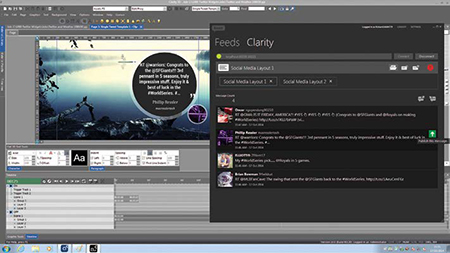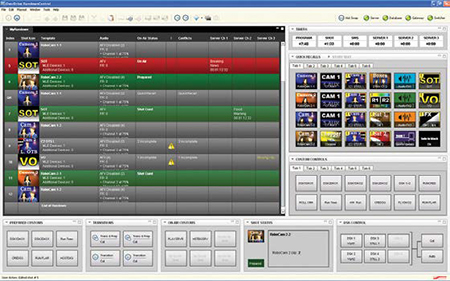Getting the Most Out of Newscasts
OTTAWA—Today’s TV news directors have to produce content not just for broadcast, but for the Web and mobile platforms as well. They also have to provide breaking news stories as they happen, rather than enjoying the luxury of compiling them for the 6 p.m. newscast.
Fortunately, continuing advances in TV news automation systems make it possible to serve all of these masters, while holding the line on staffing costs—or even reducing them. Here are some specific examples that prove this point.

Pixel Power has made it easy to add tweets into TV news broadcasts in real time using the company’s “Buzz” social media software plug-in that connects to Pixel Power’s LogoVision live playout system.SIMPLIFYING GRAPHICS PRODUCTION
With a product such as Pixel Power’s Newsroom, graphics production ceases to be a separate function in the news workflow. Instead, the Newsroom ActiveX plugin lets AP ENPS, Avid iNEWS, and Ross Inception users drag-and-drop graphics and templates into their stories as they write them. From a production standpoint, the system provides “a one-stop shop for journalists,” said Michael O’Connell, executive vice president for the U.K.-based company.
Pixel Power has also made it easy to add tweets into TV news broadcasts in realtime using the company’s “Buzz” social media software plug-in that connects to Pixel Power’s LogoVision live playout system.
FASTER, SIMPLER STORY SHARING
It’s been a long tradition that group stations share news stories, but the process can be lengthy and tedious, requiring the use of multiple web browsers, usernames and passwords or even arcane FTP interfaces to complete the process. The “Masstech for News” solution by Masstech Group in Markham, Ontario, remedies this problem by letting stations drag-and-drop video between multiple sites right within their native newsroom systems such as AP ENPS, Avid iNEWS, Ross Inception and Octopus.
“When someone in ‘Station A’ sees a story on ‘Station B’s’ rundown that they want, they can get it by dragging-and-dropping the complete story, including video and text, onto Station A’s rundown list,” said Mike Palmer, vice president and GM of Masstech Group’s news division. Users never leave their familiar newsroom system. No additional knowledge of other systems, logins or passwords is needed.

Ross Video OverdriveENHANCED PRE-PRODUCTION CAPABILITIES
The actual production of a TV newscast is a hectic event. The genius of TV news automation is that it reduces the duties demanded from the live production staff, by allowing many items such as video cliploading/playout and title/graphics generation to be pre-programmed before the content goes to air.
Get the TV Tech Newsletter
The professional video industry's #1 source for news, trends and product and tech information. Sign up below.
With advances in automation systems, “the writer/producer can also specify items such as which camera to switch to, and telling the router to switch to an incoming live report from the field,” said Isaac Hersly, president of Vizrt Americas. “This can be done using our Vizrt graphics and video workflow products in concert with the Vizrt Mosart news automation system.”
FILING FROM THE FIELD
When it comes to TV news production, the time spent travelling from news locations to the station is wasted time, unless reporters can produce and submit their reports while still on location. This is where an automation production system such as Bitcentral’s CORE:news platform comes in. It allows a reporter to do an airworthy edit of their video, and then file the completed report directly to the station’s server. This is particularly useful in breaking news situations.
“With a platform like CORE:news, there’s no waiting for news crews to return to produce their reports, and no last-minute backup at the editing stations,” said Fred Forcher, founder and CEO of the Newport Beach, Calif.- based company. “You also cut steps from the production process, because the field video doesn’t have to be uploaded and downloaded from an ftp site, and then edited back at the station.”
GETTING MORE FROM TALENTED STAFF
A smart news automation system such as Ross Video’s OverDrive “allows your best people to do more, rather than trying to delegate news production to the least skilled staff,” said Scott Bowditch, Overdrive marketing product manager for Ross Video in Irorquois, Ontario. “This means your content is being shaped by talented staff, which increases quality while it reduces errors.”
Add the fact that multiple tasks can be pre-programmed into a specific story file—such as graphics generation and camera switches—“and TV news producers can now do 10 things at once with a single button push,” Bowditch said.

Mike Palmer, vice president and general manager of Masstech Group’s news divisionCOMPLIANCE WITH WEB RIGHTS
Repurposing TV newscasts for the Web can force broadcasters to delete on-air content in those cases where they do not own the Internet rights.
Doing this deletion/substitution live is out of the question for human operators. However, a writer/producer using the Grass Valley Ignite/GV Stratus platform in pre-production “can use the MOS protocol to place markers into any line of the running order, including live reads from the anchor desk,” said Ed Casaccia, senior director of news products for Grass Valley. “The markers can be used by GV Stratus to subclip VOD items out of a line cut recording or be passed through a streaming encoder, after which online video players and ad splicing systems can act on them.”
DUE DILIGENCE
The advantages above show how automation can improve news workflows. But they provide the most benefit when station management examines the news department’s existing workflow first, before buying an automation system to improve it.
“The best processes are designed by understanding the culture of the organization, the desired ‘cycle time’ or time to create and air a story from scratch and the budget,” said Larry Thaler, president and founder of the media consulting firm Positive Flux LLC in New York. “When this approach is not followed, problems are encountered later on.”
James Careless is an award-winning journalist who has written for TV Technology since the 1990s. He has covered HDTV from the days of the six competing HDTV formats that led to the 1993 Grand Alliance, and onwards through ATSC 3.0 and OTT. He also writes for Radio World, along with other publications in aerospace, defense, public safety, streaming media, plus the amusement park industry for something different.

